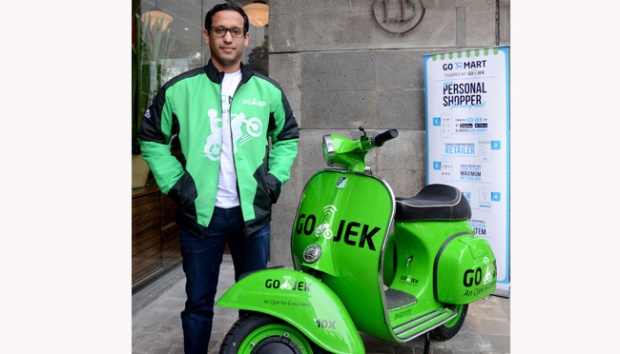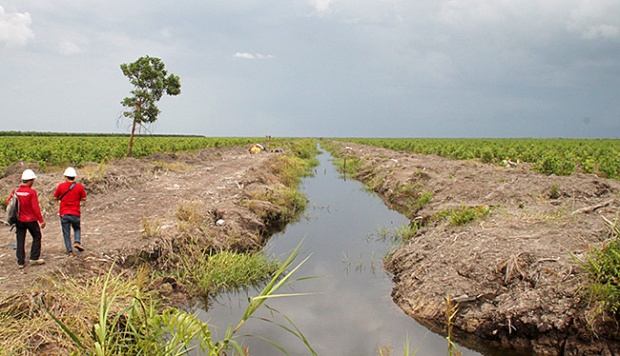
TEMPO.CO, Jakarta - The Go-Jek service online application has multiplied and diversified, in an amazingly short time. Today, customers can get Go-Jek not just to take them somewhere, but also to deliver packages and order their daily needs (through its subsidiary Go-Mart, which is connected to retail stores). If you need a massage, just go to Go-Massage, and if your domestic staff leaves you in the lurch by suddenly going back to their village, call Go-Clean and get a replacement to clean the house or the office.
Nadiem Makarim, 31, is the person behind this ingenious way of shopping by using apps in Indonesia. There is no question that with Go-Jek, he has revolutionized the motorcycle taxi business, which he launched early this year. So far, the Go-Jek app has been downloaded by no fewer than 6 million users and there are now 200,000 Go-Jek motorcycle drivers buzzing around Jakarta and seven other cities in Indonesia with their green helmets and green jackets. All this is somewhat overwhelming to Nadiem, who got his business credentials from the Harvard Business School in the United States. After all, his initial target was a modest 20,000 to 30,000 drivers joining Go-Jek this year.
Inevitably, his success story has made him an instant public figure, much in demand by the media. He did find time to meet with Tempo at a cafe in south Jakarta, following the launch of Go-Mart, his newest venture, two weeks ago.
Nadiem admitted he had never thought Go-Jek, which started out as a simple call center, would evolve into a solution to the transportation problem and, in the process, reduce unemployment. "One Go-Jek driver, who took me on his motorbike, cried when he found out who I was. He told me his life changed because of Go-Jek," Nadiem told Tempo reporters Tulus Wijanarko, Isma Savitri, Raymundus Rikang, Erwin Zachri and Maya Nawangwulan, in a special interview.
* * * *
How was the Go-Jek idea conceived?
The idea of Go-Jek first came to me out of frustration over the Jakarta traffic jams. I take ojeks (motorcycle taxis) everywhere because they're more effective than riding in cars. The problem was that ojeks were often unreliable. Even though I had a regular ojek driver, he was not always available. Then, I realized that when you manage to establish a close relationship with an ojek driver, you trust him implicitly. He buys things for you, delivers packages to other people.
I then thought: why not replicate those services and make them reliable, easy to access from anywhere and be multifunctional? If motorcycles are the fastest transportation in the city, why shouldn't people benefit from them? That triggered in me the idea to open an ojek call center. That was sometime between 2010 and 2011, and I had no money to create an application or app.
How many ojek drivers signed up with that call center?
At the beginning, I recruited 20 drivers and they recruited another 100 drivers and eventually it just grew organically and independently, under my monitoring. The management team was small, only 15 people. At that time, I had just completed my MBA and couldn't afford to hire people. So I worked at other places first.
I worked at Zalora, where I learned about technology. Then, when I moved to Kartuku, I learned about payments and pre-paid systems. In 2014, I was contacted by one of our investors and urged to take Go-Jek online.
Did the call center have many customers by then?
Actually, yes, although most of our customers used Go-Jek more as a delivery service. Transportation was a secondary thing at that time. By that time, some 500 to 600 drivers had registered.
But you didn't find a call center effective?
Imagine operating without a mobile app. A customer would call in and we had to say, "Yes, Pak, we got your order." Then we rushed to look for an available driver, calling them one by one by telephone, trying to figure out their current location. It took at least 20 minutes to complete the transaction. One problem was that not all of the drivers owned GPS trackers. I suddenly realized that the only way to expand Go-Jek would have to be through telephone apps.
You then decided to go full time with Go-Jek. Did your family approve?
Ironically, it was my family and friends who scolded me for not managing Go-Jek full time, because they saw huge potential in the business. I finally gave in and looked for investors. Within eight months, we had built an android application, an iOS and a dispatch system. We launched the app last January
Who developed the app?
We hired five developers. I knew nothing about technology, but yes, I became the project leader. I drew the app logo on paper, and it was developed and improved by the team. We also took feedbacks from Go-Jek customers.
How much was the initial investment?
I can't reveal that. We are not like other companies, announcing every new investment. What we will publicize is the impact of our venture to the nation.
Your investors seem very confident about the future of this business?
I told them, "Look, trust me when I say I believe in it and I am very confident that the business will succeed." When they saw me, the founder, focusing 100 percent on the business, of course they trusted me.
Yet, lately the app has been experiencing errors. Aren't you worried customers will move to the competition?
There has never been an app in Indonesia with so many users as Go-Jek. So far, some 6 million users have downloaded it. We have now linked this app to others, like the drivers' app, the users' app and to our dispatch system. We never imagined it would be so explosive. So, essentially, we're still going through a learning curve.
Just imagine one Go-Jek transaction flow. The customer must fill out all the blanks before ordering. That order goes to our system to be relayed it to the nearest driver around. That driver needs to be filtered by us first, whether he's on a job or not. From there, the driver who gets the order is relayed back to the customer. After that, the customer can track the driver's location. So, with six million people downloading this application, you can imagine the complexity, particularly when networks in Indonesia don't always work? Our server is down regularly, especially during the rush hour.
When will the app be fixed?
This week, the app will finally stabilize and hopefully remain stable because we are now big. Working with us are 120 engineers and we have engineering centers in Yogyakarta, Jakarta and one team in Bangalore, India.
What have been the obstacles so far? The government?
We don't see it that way. However, all the founder technology has come from overseas. This is because local investors refuse to help. Even if they did, it was low-value. Secondly, when we get foreign investment, the founder must get the technology as well as the money.
Customers love Go-Jek because their rates are cheaper, because it's subsidized. But how long can this situation last?
You should ask our competitor, who's from our neighboring county (GrabBike from Malaysia Ed.). It's because of them that we had to lower our rates. But what can we do? We don't want to lose the business.
Actually, I want this subsidy to be reduced as fast as possible. But it's difficult when our competitor still charges very low rates because we want to cover the whole market. I cannot accept a Malaysian company taking over the ojek business in Indonesia. I would rather bleed for a long time, as long as I can keep maintaining it.
Is that why you're playing the 'nationalism' card? To make Go-Jek more Indonesian and steal consumers away from the competition? (Go-Jek rates everywhere is a flat Rp 15,000 Ed.).
Yes, some of our clients choose Go-Jek because of that element. Although our app is not as nice-looking as that of the competition, our app is preferred over theirs because it's easier to use. Moreover, in our app, you can find everything. It's not just about about ordering a transportation, it's also a courier service, it's shopping from home, about food and other topics. But the nationalism factor does help quite a bit.
As for nationalism, so what if Go-Jek is owned 100 percent by Indonesians or 100 percent by foreigners? That' not the point. The point is, how many people benefit from this technology? Does it matter whether people can be rich by it? If Indonesians prosper from it, why not?
But at some point, that subsidy will have to go, right?
We plan to raise the rates. Otherwise, we would go broke (laughing). (*)
Read the full interview in this week’s edition of Tempo English Magazine























